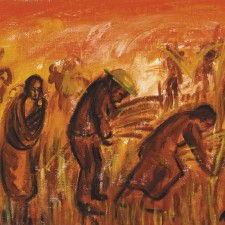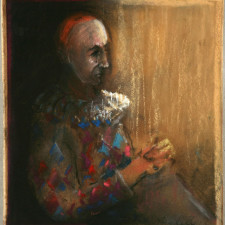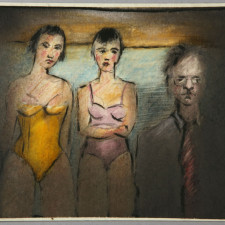Essays Icarus
Foreword to the catalogue for the “Icarus” exhibition, May 1996.
These paintings were begun over a year ago. The theme is one which has preoccupied John Kelly on a number of levels for some time.
Initially it provided him with an opportunity to explore and express the visual possibilities of figures with wings. Eventually it enabled him to articulate deeper concerns which have both particular and general resonances. Using a combination of oil, water colour and graphite, which allowed for a greater versatility and range of expression, he has produced a body of work with a profound conceptual span.
In some cases the interests are plainly within the arena of figurative exploration and manipulation. It is almost as if the character of Icarus is incidental to these considerations. Thus we encounter Icarus crucified, resurrected or as a deposition study. All ostensibly in the name of promoting figurative inquiry. In reality this marks a return in part to an earlier interest in religious subject matter. As a younger man, John Kelly produced a body of work which in content explored spiritual themes. Today the exploration continues with a greatly enhanced understanding of what constitutes spirituality.
The Icarus paintings are part of that exploration. The progress of the journey can be charted through three distinct though related movements. The first suite consists of almost twenty pencil drawings which are discrete unto themselves. They serve as an introduction to the Icarus theme – Icarus in gestation. Though they are experimental in terms of medium and figurative disposition, they neither hesitant nor tentative in effect. They are the “mis en scene” for what follows.
The second and largest suite comprises almost thirty paintings. These are characterised by the use of watercolour and graphite and show a development in the treatment of the scale of the figure – Icarus asserted. Colours are earthy with greens, browns and yellows tending to dominate.
The third and final element of the series is the Puppet suite. Here are ten paintings executed in watercolour and graphite which employ the puppet as a device to articulate the plight of Icarus. The overall effect is sombre and menacing, and expressive of finality and failure – Icarus broken. Thus is the coherence of the Icarus paintings established.
For John Kelly the Icarus myth can be equated with the creative impulses of the Artist. Believing as he does that the process of creativity is akin to a journey it is perhaps inevitable that he should use Icarus to exemplify that process. In both cases there is the initial sense of journeying without a predetermined destination in mind.
The journey becomes as important as the arrival. This demands courage and audacity. There is always the prospect of great reward but on the other hand there is the recognition that the act itself is sufficient. Antique and indeed latter day sensibilities have attributed arrogance to Icarus’ motives. The failure was in fact proof of the old adage that pride precedes a fall. Beware Juvenal, and what he said of “prayers granted by malicious gods on which a bitter heaven smiles”. This is essentially a quiescent view of the world and there are many who still derive comfort there today.
The heart of the Icarus paintings lies in the Puppet suite. Appropriately enough Icarus is seen as a puppet – broken, abused, discarded and ultimately manipulated. Yet this the point at which paradoxically we are most aware of the humanity of the figure.
Heroically, in the face of those malicious gods, the advance is sustained. The lessons learned from Icarus are not in the realm of quiescence. The lessons learned from the Icarus paintings find a resonance in Browning when he said that “a man’s reach should exceed his grasp or what’s a heaven for?” and in the recognition that the journey probably has no end.
Gerry Walker, May 1996




